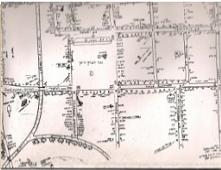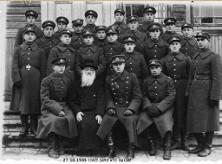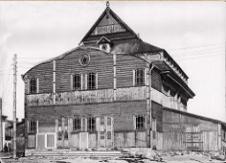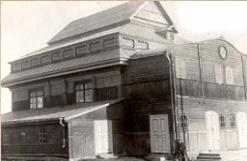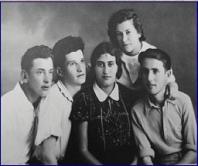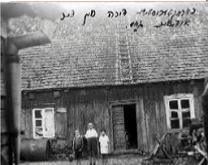VILKAVISKIS
A small town in Southern Lithuania
Where the Jewish Community is no more
2017 Our Activities
Visiting the Ausros Gymnasium in Vilkaviskis - these children won a national prize for their work on Jewish Vilkaviskis
So many thanks to their teacher Ms.Erika Anisimaviciene.
NATIONAL DOCUMENTATION COMPETITION "LITHUANIAN WAR FOR FREE AND HUMAN HISTORY"
Vilkaviškis "Aušra" gymnasium
ID-class students:
David Grieg
Justin Grumbly
Tomas Vizgirda
Outline
"Vilkaviškis Jewish Historical Memory and the Holocaust"
Vilkaviškis
2017
Introductory word
For every person, regardless of his age, social status or gender, it is important to know his roots - the history of his people, his native place. According to K. Vonegut: "Be it a tiny oasis in the wilderness, a red dense clay, a mountain slope, a rocky sea shore or a stumbling block on the metropolitan street. Everyone is putting our roots in the black earth, in the swamp or in the white sandstone sandstone, in the stone, in the asphalt or in the carpet, so that we can call this place one of the only important words - the house. " It does not matter what his native environment is, it's just important, because there's a lot of things happening for the first time: the first step has been taken, the first word is tartas, the first grin has been given ... And all this goes on for centuries, millennia ... The card changes once ... And only the story allowed to turn back into the forgotten events of the millennia, centuries, decades. Recall the stories of the people you live. In our work we would like to turn one of our home town history page - the destiny of Vilkaviškis Jewish community during the Second World War. We will try to discuss what has happened to the representatives of this nation, we will look at the fate of individual people.
The traces of the disappeared nation
Vilkaviškis is a small town in south-western Lithuania with a population of about 11,000 inhabitants. It is a border town that was politically important during the Second World War. In fact, Vilkaviškis, as a city, was never very famous in Lithuania, but his name was evident in the famous people born in his area, namely: dr. J. Basanavicius (Oskabaliai), dr. V. Kudirka (Paežeriai), S. Nėris (Alvitas-Kiršai), V. Pietaris (Gudeliai), P. Vaičaitis (Santakai), P. Masiotas (Travestors), K. Bradūnas (Kiršai) and others.
For the first time in written sources, Vilkaviškis was mentioned in the 16th century. Beginning in about 1545, when Queen Bona Sforza appointed a dry wooden Jewish synagogue to build. It is this historic event that presents not only the city, but also allows us to assume that a large Jewish community should have lived in this city then, which needed a religious building in order to feel full of people of that city and could foster the traditions of its people here. It is also paradoxical that the Jewish people themselves became known to Vilkaviškis because every "brighter Lithuanian Jew" knew that "the oldest and most expensive manuscript of the Lithuanian Jewish Scripture" was kept in Vilkaviškis Synagogue. "
The city ran, the city grew, and its community grew too. As we know from various stories, our grandparents have already said that Vilkaviškis before the Second World War lived a very large Jewish community. This national minority in Vilkaviškis was the most numerous. According to A. Žilinskas, "1923 According to the figures, out of 7263 people, 3206 (44%) were Jews. The citizens of this nationality of the Republic of Lithuania formed almost half of the pre-war city council. They presided over the county council. "Therefore, the Jewish community was not only plentiful but also influential, which could have led to significant changes in the city. It can also be assumed that the local people had a good deal with the Jews. In general, looking back at the past, the Lithuanian nation is famous for its tolerance to the people of another religion or nation, and in historical sources, our capital Vilnius is often called the name of North Jerusalem, and Lithuanian Jews are Litvaks.
The fact that the Jewish community in Vilkaviškis really had a unique position is also evidenced by the abundance of buildings of various uses. First of all, from 1545 to 1941 The Great Synagogue of Vilkaviškis acted (see Appendix 1). Synagogue was the most important Jewish spiritual and cultural center in Vilkaviškis. She was wooden, three-story and served more than 4000 people in the community during holidays and various celebrations. The synagogue was made up of a large oak sacred ark, decorated with carved ornaments, and it was facing Jerusalem. It contained several antique Torah rolls from Spanish Jews and other Torah rolls. Several buildings consisted of the synagogue religious center: the Great Synagogue, the Lower Synagogue, Beit Midrash (Torai study), Vai-Ha'Kehilla (community administration and rabbi institution). In addition to this synagogue in Vilkaviškis, there were several smaller synagogues in Lithuania in the interwar period in Lithuania: the shelters for the elderly and other houses. They were led by rabbis: the 19th century In the second half - L. Liandau, in the 20th century. In the first half - E. Shereševsky. A real Hebrew gymnasium was established in Vilkaviškis, in which the sciences were taught in Hebrew. According to Y. Ankorionis (a resident of Israel) in his letter to the Vilkaviškis Regional Museum: "The Hebrew Gymnasium was active and prosperous between the two world wars, from 1919-1940, during the years of freedom and independence of Lithuania. This golden age of Apart from synagogues and representatives of the Hebrew real gymnasium Jewish nationality belonged to other important objects of the city. In the first place, the most important object for the people of that age was the Vilkaviškis Brewery and Horse Processing Factory, one of its co-owners was Jew S. Soblen. This fabrikėlis was famous not only in Vilkaviškis, but also throughout Lithuania. Jew Taboriškis had a mill and an oil mill, I. Zilberis printing house, I. Hazon had a famous sewing machine. Some ladies from Kaunas came here to dress some fashionable clothes. There were also various shops and restaurants at that time belonging to the Jews. Thus, the Vilkaviškis Jews were influential and enjoyed a high social status in the city community. Urban commerce and crafts were in the hands of the Jews, they lived calmly and peacefully with the locals (see Appendices 2-4).
1939-1945 This is a trial period for human values. It's the time when the real faces of man appeared, the period that took away most of the lives in the history of mankind, it's a pity that they would not be innocent ... As Fennelon said: "War is evil, causing shame to the human race." The world turned upside down, there was no Rights, or unjust, were only strong and weak ... Unfortunately, during the Second World War, the Vilkaviškis Jewish community found itself in the weaknesses of the weak.
Lithuania was not given neutrality during the Second World War, so both our territory and people experienced what the war means. First of all, Lithuanians in 1940 In June, they experienced Russian occupation. The Russian government quickly nationalized private Vilkaviškis hospitals, factory workers, workshops and other companies. Vilkaviškis, as a frontier town, was soon plunged into Russian troops. But all this was only the initial steps taken by the occupants. 1941 On June 13, about 23 hours, all Russian soldiers were informed "to remove Fascist elements from distant parts of the Soviet Union". So, on June 13-15, about 569 people were taken from Vilkaviškis County: 294 men and 275 women. It was only the first wave of occupation. No one could even guess what people would get when their territory was captured by the Germans ...
1941 On June 22, at 7 o'clock in the morning, the German Army aircraft bombed Vilkaviškis city. There was a panic - people were fleeing their homes, because the city was plagued with fire and smoke. At 11 am, the first German soldiers appeared in Vilkaviškis (see Appendix 5). They took office, took all uniformed clerks into captivity. However, the Russian troops did not give up and the shootings continued. Already on the first day of the war, the city of Vilkaviškis was severely hit because of the destruction of the Evangelical Church, the shoe factory, the trunk and horse-drawn carving factory, the tobacco factory Bravol, the cinema "Forum", the hospital, the synagogue, the two mills, the bookstore, the candy factory "Kodino", bank, power station, constricted seminary, court building. In addition to the shelter, 645 families remained.
According to sources, the western part of the city, where there were many wooden buildings, hit the most. A rumor was spread among the indigenous population that the Germans, in the event of a fire in the western part of the city, prevented the extermination of Jewish homes. The genocide of the Jewish people gradually began in Vilkaviškis ...
As we mentioned earlier, a large Jewish community lived in Vilkaviškis before the Second World War. It is known that the Germans who occupied Poland plundered many Jews near Vištytis (Vilkaviškis Rayon) and handed them over to Lithuania after several days of negotiations. A. Smetona's government accepted the Jews and divided them into larger cities. The Vilkaviškis Jews adopted their compatriots and placed them at their homes or hired them to flourish. There were a lot of intelligentsia among the arrivals: doctors, engineers, teachers. So in the heat of the Second World War in Vilkaviškis, near the local Jews, there were also Jews from Poland.
During the first days of occupation, the Jews were still living in their own homes, in their apartments. Then they were all embedded in the ghetto, which, paradoxically, became the territory of the seminary. As local residents have said, many Jews did not believe that they would be killed, thought they would be taken to the old Jewish lands. The Jews tried to adapt to the changed living conditions: "At the farmer's request, they were sent to work in villages. But, as the locals said, they did not hear that at least one had escaped. "The German authorities tried to include the local population in their Jewish politics. The guards, who were usually assembled from local demons, mocked the Jews and tortured them in various ways. But all this was just the beginning of what happened later ...
According to Sajauskas, in July and September, the Nazis killed about 3,000 Jewish people in Vilkaviškis. When the Nazis entered Lithuania, all the Jews had to wear a yellow star, the "Star of David", dressed up in clothing, and were immediately forced to work. True, these works were later related to their annihilation.
The arrested Jews had to dig a 25-meter-long and several-meter-wide ditch in their land at the end of July near the Vilkaviškis barracks. Lithuanian people was also Jewish ki
The arrested Jews had to dig a 25-meter-long, multi-meter wide ditch, a tomb of their own nation, in the polygon near the Vilkaviškis barracks in the end of July. July 28th
Child) Vilkaviškis Jews were shot by Vilkaviškis policemen this time. The property of the victims was later sold out to local residents. As we see, part of the Lithuanian, loyal Nazi politicians contributed partly to the genocide of the Jewish people. What could have encouraged Lithuanians to contribute to the Jews' execution is difficult to say: perhaps the desire for power or property? But such actions, as people, are and will be shameful.
About how the Jewish children and women were murdered in Vilkaviskis on the last day of the Holocaust, wrote DvorakosAlexnansky in his letter of condolence. The contents of the letter reveal that mothers were forced to bring their children to the death pit. Later on the children, who were alive in the pits, threw garnets. All these examples illustrate the extent and severity of the atrocities of the Jewish people. Such acts can not be either legalized or acquitted, they are simply supernatural.
Rescue those who are condemned ...
"It's enough for the world to save everyone
Although quite small, dare to start. "
(B. Ferrero)
During the Holocaust, not all people were indifferent to the fate of the Jews. Risking the lives of their own people and their close people, Vilkaviškis District residents hid and rescued Jewish people. There have been cases where you managed to survive and survive. To remain both sides - both those who hide and those who hide ... In such cases, it is worth remembering the Jewish saying from Talmud: "The one who saves one life saves the whole world." But it was a matter of how much was wrongly blamed. ..
According to G. Procuta, "The salvation of the Jewish people has always been associated with the fear of the life of the Savior and his relatives. The circumstances of the rescue were difficult and difficult, so that at least 5-10 people would have to be helped to save one Jew. One survivor was threatened by entire families. Despite the risk, many Lithuanians were prepared to rescue the Jews. "We want to revive these moments of history.
Have you ever wondered what a person thought, knowing that he would soon die? If it is a punishment for the crime, it may have repelled them. If the end of a natural way of life, perhaps a person has been reflecting on his own destiny and forever forgiving with his loved ones, friends. But how to accept death when you are innocent of neither man nor the state, nor politicians ... How to feel to the mother who carries her child to the grave? What does a child feel, knowing that he, who knows why, is doomed to die? How to wait for the coming death? .. Indeed, it would be difficult for us to answer these questions. But as an example, we would like to present a fragment of the letter of Aleksandr Dvorakos Aleksansky living in Vilkaviškis. She was doomed to die, but in the last few hours she wrote a letter to a brother living in America (see Appendix 6).
My dear brother Zisala,
I leave this letter to you, and this will be my last letter forever. I write this letter and wait for me to kill. I want to leave you with this handwritten document that describes the massacre of the Jews. Of all our families, I was the only one left alive, I walked from the fields to the forest like one stone, and no one moved my finger to help me.
An announcement was made that those who hid the Jews would be shot. This instruction is printed in all newspapers. All the Jews in the neighborhood are already killed. In Kaunas and Vilnius all the Jews were killed. In Vilkaviškis, there are still a few remaining, those who are hiding.
I am one of the survivors, but I am waiting for my death to die at any moment. Yes, it's time for us, Jews, to be destroyed by the hands of the murderers. How can God look at the suffering of our little children? On the children, who were buried alive in the pits, they threw grenades. Good God, how can you see such things? <...>
You, my dear brother, will only be alive from our family. Before I die, I wish you a good life for you and for your children. My dear brother Zisla, I write to you this last letter, I have tears, I cry, I know that I will soon be killed and I can not change the destiny which God has appointed to the Jews.
The world will pay off with our killers who have shed innocent blood. The blood of the innocent will ask for revenge forever. But after all this will not be possible. You will read newspapers about these events. I ask all the Jews to keep quiet, to take revenge on our murderers who have shed our blood. We, Jews, only a few, and soon we will die. <...>
It's time for me to leave you forever, it's so hard for me, my dear brother, and I believe everything has already been lost. It's so hard for me to put a pen because I know it's been forever. And this separation will be eternal. I wanted to be together for so many occasions, but I'm afraid that everything has already been lost. I want to sit here until they bring me to the pit of my death where I will die. It's hard to leave you.
I feel that the forces abandon my body. <...>
Your sister Dvorak
The content of the letter reflects not only the internal state of a person condemned to death, but this letter is also a historical document testifying to the brutal treatment of the Vilkaviškis Jews. True, it should be noted that the Wolves U. and A. Kumpiai family tried to save Dvorak's life, but it was issued. Later A. Kumpys in 1957 Dvorak's letter was sent to Cuba, where her brother Zisala was living at that time.
Beautiful examples of how the Welsh-family families hid the Jews from impending death are not one and not two. 1963 The International School of Holocaust Studies, YadVashem, has started to honor Jews and reward them. Such people were given the certificate of the World Peoples Righteous. The righteous of the peoples of the world is the title of honor given by the State of Israel to the citizens of other countries who have rescued the victims of the Holocaust. One has to admit that the inhabitants of Lithuania for a long time hid those who were such persons, and only after 1990, after the restoration of independence of Lithuania, people were found who had accomplished their feats. It is great that the family of the Vilkaviškis district received the certificate of the righteous of the Worlds for the life of the surviving Olga Gurvičiūtė. The story of her salvation is written in S. Binkienė's book "And Without A Gun Warrior" (1967).
Righteous people of the world, Jurgis and Ona Rimša, Justina and Juozas Rimša, who saved Olga Gurvičiūtė
After lots of hiding places in Olga Gurvičiūtė, sculptor Petras Rimša housed in Kaunas, but in his small bottle in Kaunas Olga could not stay in 1942. In October, the brother of Peter Rimša, Juozas secretly carried Olga to his and his brother's common home in Vilkaviškis district, in the Pilviškės district, in the village of Naudis. In this farmstead, Juozas Rimša and his wife Justina, his brother Jurgis lived Rimcha with her wife, Ona and son of Aida, and in 1944 Born on daughter Onute. So unexpectedly in this family
Olga was taken to the family as an equal member of the family, and Olga was introduced to all the hired servants Olga as the father-in-law of Stepan, whom Petras Rimša housed and sent to her brothers in the village. All the family members of the Lambs are guarded by Olga and have been released.
In addition to the heroic family of the Limnies, there were more families in Vilkaviskis who helped the Jewish people during the Second World War. Despite the perilous danger to themselves and to their families, there were people who, while living in poor conditions, tried to rescue the condemned, so that they would not enter the hands of the savage bellies. These people used their heart-worship and shared with the victims the last-minute bite of the bread, healed their physical and mental wounds as much as possible, gave them a living place - a place of refuge, gave hope to live and fight.
Vidas Voveraityte-Vosylienė's story about Gita Liūtė
<...> When the terrible specter of the Second World War rebounded into peaceful Lithuanian villages and towns, the shadow of death also shifted. He was brought to Lithuania by the Germans fascists who "came out". The terrible destruction of the Jewish people in a good way, although I was still a kid. The German authorities, with the help of local civil servants and young people, began their black work. The pilgrims of Pilviškės, Antanavas and neighboring towns returned to the pits near the village of Pilviškės, farmer in the land of Lozoraitis.
Upon the mass massacre of the Jews GitaLiurytė and two other Jews were hiding in Uleck. The cabin was installed on a double hill ("cyte") on the house, where there was no place to lie down or sit down. After the war, Vita, hugging Gita, remembered: "Vidut, you do not know what we have suffered. Armed murderers are walking around, silhouetted shots and are not waiting for the future. "
Without wishing to risk the Uleck family, Gita and her friends flashed to my father's house in the village of Piliūnai with Jonas Voveraitė. The runners were accompanied by a citizen of the city Kaknevičienė.
Our family grew up to five children. Parents have explained to parents why Danutė should hide. We were obliged to follow the people coming to us and warn Danutė. The Danube knew nothing about neighbors, even the father's sister. Danutė called our parents aunt and mother.
Still, after suspicion of somebody, I began to spread the language of my daddy's hidden jewish after the village.
Upon agreement with Father in the village of Kaskawki, Tolkiškės village, one night, Joanna's sister drove Danutė to the farmstead. From there her father moved to the village of Nendrinis near Antanavas near the Bosik. Here, secret Danutė was baptized, accepted the Catholic faith.
When the German army headquarters settled down near the Bosikai Homestead, Danutė was taken to Antoselė, Totoraite - Paškauskiene.
At the end of the war, Danutė came to our house after all the wanderings, telling strangers that she was the eldest sister.
A feat of Ursule Stankevičienė
This story was remembered by Janina Feldberg: And again began the craving for a cold 1941 December of the winter. In the biggest cold - 35C, searching for a shelter for our little Ada, who then turned 3 years old. <...> So, we missed 10 days before we came to a woman named Uršulė Stankevičienė, in the village of Opšrutė. She was a widow, mother of nine children, who lived with her family in one room and kitchenette. After receiving great prayers and supplications, she accepted Ada, with mercy and without any pay, she left the girl to herself.
After a while, we learned that the neighbors had accused her of hiding Jews. Gestapo came and searched, and after finding nothing with her, took her with the girl to the gestap, asked her and threatened her, demanded that she tell her the truth about her life. Despite the threats, she did not give anything and released her along with our daughter Ada. Her daughter was released in 1944. in August. She was ill with jaundice to our greatest disaster and died in December 1944. "
Thus, a person is a dual personality - he has both a bright, able to help, and a dark, capable of destroying, destroying a particle. War is the time that blazes our souls and shows us who we are really - the saviors or destroyers of mankind. Although black story pages are often not reminiscent of, but it is not much to be rejoiced, however, I would like to emphasize that, taking into account the total population of the country and the number of World Righteous Persons, Lithuania is the second largest state in Europe that saved the Jews during the Second World War. During the German occupation (1941-1944), 2500-4000 Jews were rescued and concealed, and more than 25,000 people were able to participate in the rescue of Jews. A large number of Jews were also saved in Vilkaviskis (see Appendix 7). Unfortunately, as we have mentioned, there were many Lithuanian traitors and murderers. Lithuanian Jews
An association based in Israel has published on its website about 3,000 surnames, which according to them have been involved in the massacre of Jews. There are even 51 people from Vilkaviskis. The exact number of such lists is hard to say. However, we should not turn away from the responsibility of our fellow citizens. We, the coming generations, should prove that we learned painful past lessons and not repeat them more. We need to get rid of indifference, we have to cultivate mutual understanding and compassion, live and act with humanity.
